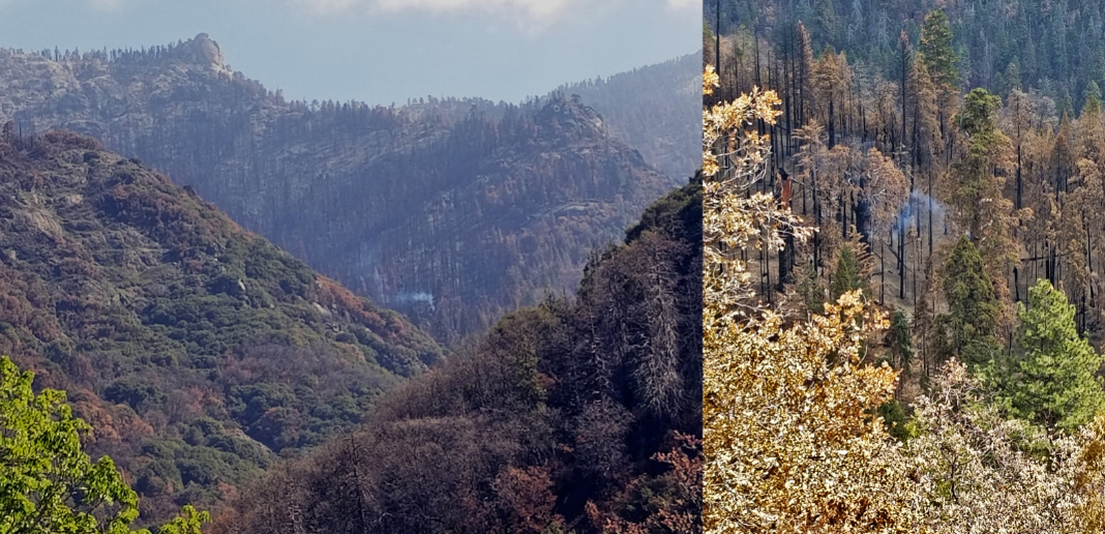On a long, recent trudge through forest burned in California’s 2020 Castle Fire, a six-person survey crew peered at a curiosity in the distance.
“We saw a little tiny smudge of white and wondered if it was snow on a distant slope,” said Nate Stephenson, a forest scientist with the U.S. Geological Survey. Upon closer inspection, it wasn’t snow. It was smoke, coming from an iconic giant sequoia. “It would put out puffs of smoke,” recalled Stephenson, of the April 22 sighting.
The remote tree has smoldered (burning without flames) since fires torched sequoia groves in Sequoia and Kings Canyon National Parks in September 2020. The rare smolder is representative of the West’s intensified modern fire regime: A potent combination of warming climes and vastly overgrown, mismanaged forests, among other factors, has left even the stalwart giants of the Sierra Nevada vulnerable to flames. They’re the largest trees on Earth. Yet as the U.S. Forest Service notes, “most of these ancient trees lived through hundreds of fires, yet modern wildfires are killing them.”
Early estimates, though still preliminary, found the Castle Fire killed about 10 percent of all natural sequoias in the Sierra Nevada, explained Stephenson, who researches sequoias. “It was horrific,” he said. “It killed lots and lots and lots of the big sequoias.”
“It was horrific.”
California forests, and perhaps some sequoia groves, may have a rough 2021 fire season ahead — following 2020’s already historic, nightmarish fire season. The Golden State only received half of its average precipitation this winter. Nearly all of California, like much of the West, is now in some stage of drought.
“The fact areas are still smoldering and smoking from the 2020 Castle Fire demonstrates how dry the park is,” Leif Mathiesen, the assistant fire management officer for Sequoia and Kings Canyon National Parks, said in a statement. “With the low amount of snowfall and rain this year, there may be additional discoveries as spring transitions into summer.”
Recently, NPS staff saw a still smoldering and smoking giant sequoia tree from last year’s Castle Fire in the SW area of Sequoia NP. It’s well away from any trails and poses no threats to life or property. Read full story: https://t.co/zXLPDKwTky pic.twitter.com/v6NkF8GMvM
— Sequoia & Kings Cyn (@SequoiaKingsNPS) May 5, 2021

The smoldering sequoia in Board Camp Grove on April 22, 2021.
Image: NPS / Tony Caprio
Smoldering sequoia
A giant sequoia smoldering through the winter is rare. It’s something Stephenson has only seen a couple of times in the past during exceptionally dry winters, specifically during California’s 2012-2016 drought.
How can a tree smolder for so long? Well, a giant Sequoia is an exceptional tree. A medium-sized trunk is as thick as a “railroad passenger car stood up on end,” explained Stephenson. Past fires and other events commonly leave great cavities of dry, dead wood in sequoias. During fires, embers can find their way into these holes, and start burning. A dry winter, however, won’t extinguish the burning. But it’s too cold for fires to burn fast or with flame. So it smolders. “It has a huge supply of dead wood,” said Stephenson.

A giant Sequoia burned and “decapitated” by the 2020 Castle Fire.
Image: Al Seib / Los Angeles Times via getty images
Sequoia’s today have unique, and daunting, challenges. The big trees are indeed well-adapted to live with fire. Fire is, in fact, necessary for the trees to perpetuate, as hot air from blazes opens the sequoias’ tough cones and allows seeds to rain upon the forest floor.
-
Yet, after a century of intense federal fire suppression in the U.S., sequoias can live in grossly overcrowded forests. This means modern blazes have unnatural bounties of fuel to burn, which contributes to infernos.
-
California has experienced a massive tree die-off. Some 150 million trees have died since 2010, with prolonged drought between 2012 and 2016 playing a prominent role in weakening trees and allowing voracious bark beetles to consume the trees’ inner tissues. These dead trees are now fuel for fires, which may have contributed to recent California infernos.
-
In today’s forests, there aren’t just more trees and vegetation available to burn. Everything is also drier, as a warmer climate parches plants. “It takes just a little bit of warming to lead to a lot more burning,” Jennifer Balch, an associate professor of geography at the University of Colorado Boulder who researches fire ecology, told Mashable in 2020. In 2020, the Northern Hemisphere experienced its hottest summer on record.
This all adds up to the bad, unhealthy infernos we’ve seen in recent years. What does this portend for the great sequoias? Sequoia and forest experts, like Stephenson, are immersed in answering these questions. For example, they’re observing how modern infernos, which can light the crowns of trees on fire, may impact sequoia seeds. Are these severe fires also burning and killing the seeds, meaning fresh seedlings aren’t born following an extreme blaze? “That’s why we’re going to do a formal study,” said Stephenson.
SEE ALSO: 3 big wildfire questions, answered
The smoking sequoia — which may keep smoldering or burning through next winter (there’s really nothing to stop it) — is just one visible sign of how modern wildfires, like the Castle Fire, affect the biggest trees on Earth. It’s an emerging story, and crews will visit more of the recently burned groves. Already, it’s certain that a huge number of giant sequoias are already dead. How many really died, exactly, is the question.
“It’s not going to be a pretty picture,” said Stephenson.
